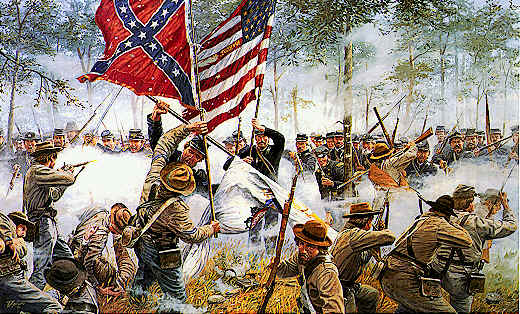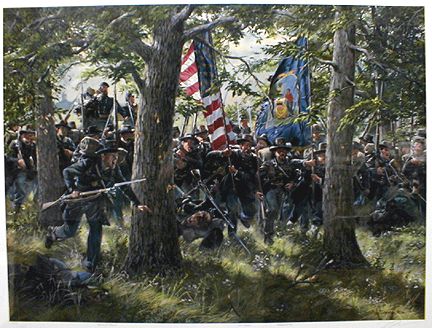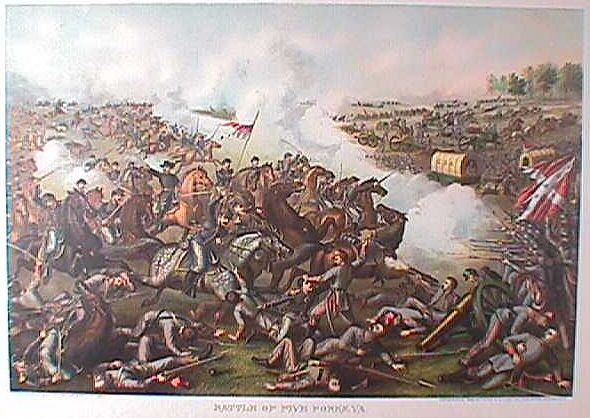
HISTORY OF 2ND CORPS
Seige of Yorktown; Fair Oaks; Oak Grove; Gaines' Mill; Savage Station; Peach Orchard; White Oak Swamp; Glendale; Malvern Hill; Antietam; Fredericksburg; Chancellorsville; Gettysburg; Bristoe Station; Mine Run; Morton's Ford; Wilderness; Corbin's Bridge; Po River; Spotsylvania; North Anna; Totopotomoy; Cold Harbor; Assault on Petersburg, June 18th; Jerusalem Road; Strawberry Plains; Deep Bottom; Ream's Station; Popular Spring Church; Boydton Road; Hatcher's Run; Seige of Petersburg; White Oak Road; Sutherland Station; Sailor's Creek; Farmville, Appomattox.
The second corps was prominent by reason of its longer and continuous service, larger organization, hardest fighting, and greatest number of casualties. Within its ranks was the regiment which sustained the largest percentage of loss in any one action; also, the regiment which sustained the greatest numerical loss during its term of service; while, of the one hundred regiments in the Union Army which lost the most men in battle, thirty-five of them belonged to the Second Corps.
The corps was organized under General Orders No. 101, march 13, 1862, which assigned General Edwin V. Sumner to its command, and Generals Richardson, Sedgwick, and Blenker to the command of its divisions. Within three weeks of its organization, the corps moved with McClellan's Army of the Peninsula, excepting Blenkers Division, which was withdrawn on March 31st from McClellan's command, and ordered to reinforce Fremont's troops in Western Virginia. Blenker's Division never rejoined the corps, in fact, it never really joined. The remaining two divisions, which constituted the corps, Numbered 21,500 men, of whom 18,000 were present for duty.
The first general engagement of the corps occurred at Fair Oaks, where Sumner's prompt and soldierly action brought the corps on the field in time to retrieve a serious disaster, and change a rout into a victory. The casualties of the two divisions in that battle amounted to 196 killed, 899 wounded, and 90 missing. In the Seven Days' Battle it lost 201 killed, 1,195 wounded, and 1,024 mssing. Upon the withdrawal of the Army from before Richmond, it moved to the support of Pope atsecond Bull Run, arriving on that field in time to go into position at Chantilly, but was not engaged.
The corps then marched on the maryland campaign, during which French's (Third) Division was added. At Antietam, the corps was prominently engaged, its casualties amounting to more than double that of any other corps on the field. Out of 15,000 effectives, it lost 883 killed, 3,859 wounded, and 396 missing; total 5,138. Nearly one-half of these casualties occurred in Sedgwick's (Second) Division, in its bloody and ill-planned advance on the Dunker Church, an affair which was under Sumner's personal direction. The Irish Brigade, of Richardson's (First) Division, also sustained a terrible loss in its fight at the "Bloody Lane," but, at the same time, inflicted a greater one on the enemy. General Richardson was killed in this battle, and General Sedgwick received three wounds.
The next battle was at fredericksburg. In the meantime, Sumner had been promoted to the command of a Grand Division -- Second and Ninth Corps -- and General Darius N. Couch, a division commander of the Fourth Corps, was appointed to his place. General Hancock suceeded to the command of Richardson's (First) Division, and General Howard took Sedgwick's place, the latter being absent on account of wounds. The loss of the corps at fredericksburg exceeded that of any other in battle, amounting to 412 killed, 3,214 wounded, and 488 missing, one-half of which fell on Hancock's Division in the unsuccessful assault on Marye's Heights. The percentage of loss in Hancock's Division was large, Caldwell's (First) Brigade losing 46 percent killed and wounded.
After Fredericksburg, the Grand Divisions were discontinued, and General Sumner retiring on account of age and physical disabilities, General Couch remained in command. Couch led the corps at Chancellorsville, with Hancock, Gibbon, and French as his division commanders. Sedgwick had been promoted to the command of the Sixth Corps, and Howard, who had commanded Sedgwick's Division at fredericksburg, was promoted to the command of Eleventh Corps. At Chancellorsvillethe principal part of the Second Corps' fighting fell on hancock's Division, its skirmish line, under Colonel Nelson A. miles, distinguishing itself by a successful resistance to a strong attack of the enemy, making one of the most interesting episodes in the history of that battle. During the fighting atChancellorsville, Gibbon's (Second) Division remained at Fredericksburg, where it supported Sedgwick's operations, but with slight loss.
Not long after Chancellorsville, General Couch was elieved at his own requiest, Hancock succeeding command of the corps, and caldwell to that of Hancock's Division. While on the march to Gettysburg, General Alex Hay's Brigade joined, and was assigned to the Third Division, Hays taking command of ths division. At Gettysburg, the corps was hotly engaged in the battles of the second and third days, encountering there the hardest fighting in its experience, and winning there its grandest laurels; on the second day, in the fighting at the wheatfield, and on the third, in the repulse of Pickett's Charge, which was directed against hancock's position. The fighting was deadly in the extreme, the percentage of loss in the First Minnesota, Gibbon's Division, being without equal in the records of modern warfare. The loss in the corps was 796 killed, 3,186 wounded and 368 missing; a total of 4,350 out of less than 10,500 engaged. Gibbon's Division suffered the most, the percentage in Harrow's (First) Brigade being unusually severe. Hancock and Gibbon were seriously wounded, while the brigade commanders, Zook, Cross, Willard, and Sherrill were killed. The monthly return of the corps, June 30, 1863, shows an aggregate of 22,336 borne on the rolls, but shows only 13,056 "present for duty." From the latter deduct the usual proportion of non-combatants, -- the muscians, teamsters, cooks, servants and stragglers, and it becomes doubtful if the corps had over 10,000 muskets in line at Gettysburg.
General Hancock's wounds necessitated an absence of several months. General William Hays was placed in command of the corps immediately after the battle of Gettysburg, retaining the command until August 12th, when he was relieved by General Gouverneur K. Warren, who was ordered to take Hancock's place during the latter's absence. Warren had distinguished himself at Gettysburg by his quick comprehension of the critical situation at Little Round Top, and by the energetic promptness with which he remedied the difficulty. He had also made a brilliant reputation in the Fifth Corps, and as the chief topographical officer of the Army of the Potomac. He was, subsequently, in command at Bristoe Station, a Second Corps affair, and one which was noticeable for the dash with which officers and men fought, together with the superior ability displayed by Warren himself. He also commanded at Mine Run and Morton's Ford, the divisions at that time being under Generals Caldwell, Webb, and Alex Hays.
Upon the reorganization of the Army of the Potomac, March 23, 1864, the Third Corps was discontinued, and two of its three divisions were ordered transferred to the Second. Under this arrangement the Second Corps was increased to 81 regiments of infantry and 10 batteries of light artillery. The material of the old Second Corps was consolidated into two divisions, under Generals Barlow and Gibbon; the two divisions of the Third Corps were transferred intact, and were numbered the Third and Fourth, with Generals Birney and Mott in command. By this accession, the Second Corps attained in April, 1864, an aggregate strength of 46,363, with 28,854 present for duty.
General Hancock, having partially recovered from his wounds, resumed command, and led his battle-scarred divisions across the Rapidan. In the battle of the Wilderness the corps lost 699 killed, 3,877 wounded, and 516 missing; total 5,092, half of this loss falling on Birney's (Third) Division. General Alex hays, commanding the Second Brigade of Birney's Division, was among the killed.
At Spotsylvania, the Second Corps again attained a glorious place in history by Hancock's brilliant and successful assault on the morning of May 12th. During the fighting around Spotsylvania, Mott's (Fourth) Division became so depleted by casualties, and by the loss of several regiments whose term of service had expired, that it was discontinued and merged into Birney's Division, Mott retaining the command of a brigade. The casualties of the corps in the various actions around Spotsylvania, from May 8th to the 19th, aggregated 894 killed, 4,947 wounded, and 801 missing; total 6,642, or over one-third of the loss in the entire Army of the Potomac, including the Ninth Corps. The heaviest loss occurred in Barlow's (First) Division. Up to this time the second Corps had not lost a color nor a gun, although it had previously captured 44 stands of colors from the enemy.
After more of hard and continuous fighting at the North Anna, and along the Totopotomoy, the corps reached the memorable field of Cold Harbor. While at Spotsylvania it had been reinforced by a brigade of heavy artillery regiments, acting as infantry, and by the brigade known as the Corcoran Legion, so that at Cold Harbor it numebred 53,831 present and absent, with 26,900 "present for duty." Its loss at Cold Harbor including eleven days in the trenches, was 494 killed, 2,442 wounded, and 574 missing; total, 3,510. Birney's Division was but slightly engaged.
In the assaults on the Petersburg entrenchment's, June 16th-18th, the Corps is again creditied with the largest casualty list. In one of these attacks, the First Maine Heavy Artillery sustained the most remarkable loss of any regimental organization, in any one action, during the war. At this time the corps contained 85 regiments; its effective strength, however, was less than at any previous date. The corps recrossed the james, and fought at Deep Bottom, July 26th, and again on August 14th; then, having returned to the lines around Petersburg, Barlow's and Birney's Divisions were engaged at Ream's Station, on August 25th, a disastrous and unfortunate affair, in which it lost a large number of men captured.
At the battle of Boydton Road, october 27, 1864, the division commanders were Generals Egan and Mott, the First Division (Miles') being retained in the trenches. In November,1864, General Hancock was assigned to other duty, and General Andrew A. Humphreys, chief of staff to the Army of the Potomac, succeeded to his position. he was in command during the final campaign, the divisions being under Generals Miles, William Hays, and Mott. The corps fought its last battle at Farmville, April 7, 1865, two days before Lee's surrender. In this final action General Thomas A Smyth, a brigadier in Hay's (Second) Division, was killed. Smyth was an officer with a brilliant reputation, and at one time commanded the famous-Irish Brigade.
The history of the Second Corps was identical with that of the Army of the Potomac. It needs no words of praise; its record is unsurpassed.
Source: "Regimental Losses in the American Civil War (1861-1865)" - William P. Fox


